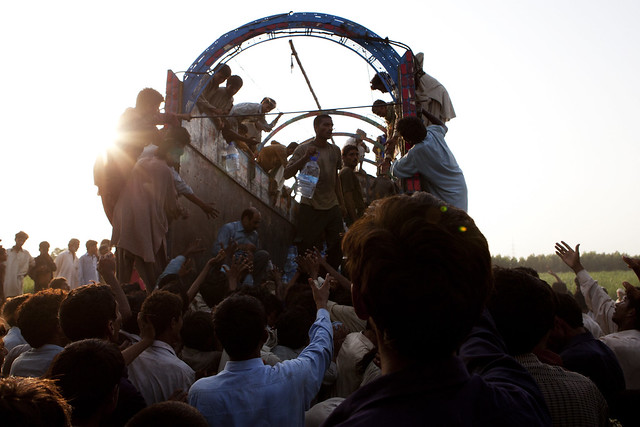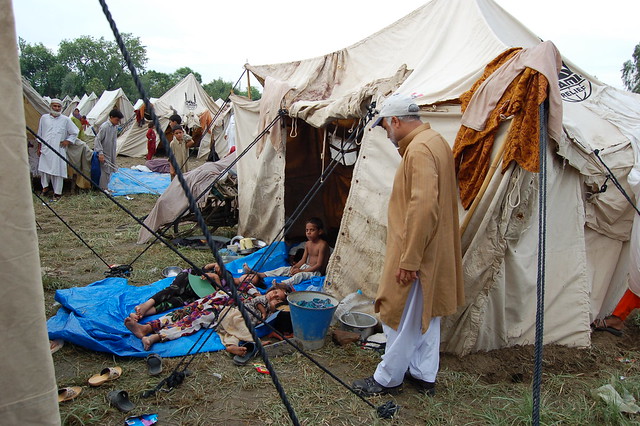by boatsie, DailyKos, December 7, 2010
In a stunning series of short films depicting last summer's biblical floods, Pakistan today issued a passionate and powerful appeal to the heart and soul of the international community.
Calling for COP16 negotiators to rise above politics and circumnavigate the complexities which have a stranglehold on both process and progress, they called on the parties to reach agreement on an adaptation fund which recognizes and adequately addresses the disproportionate impact of climate change on the world's most vulnerable populations.
"Pakistan is on the front line in two wars, the war against terrorism and the war against climate change," said Khalid Sherdit, Director General of PDMA and General Relief, Punjab. "Both battles need global coordination and cooperation. Both are unpredictable. But in the war against climate change, there is no exit plan."
Monsoon rains in the Khyber-Pakhtunkhwa, Sindh, Punjab and Balochistan regions of Pakistan initiated the 2010 flood, which severely impacted the Indus River basin.
Today, four months after the floods, levels of malnutrition remain at 40% in some areas of Pakistan and millions still lack access to healthcare.
July 2010. Flooding in the district of Muzzafargarh ... A truck with private donations of water is engulfed by IDP's makeshift camp for persons displaced by the extensive flooding in Gujrat Town, district of Muzzafargarh. ...Those fleeing the flooding reported an estimated 200 houses washed away or destroyed by flooding. Most inhabitants of Gujrat earn a living through agriculture, farming rice, sugar and cotton. No deaths were reported by the villagers; however, they estimate that 90% of the herds of cattle and goats have been lost to flooding. ..Within the makeshift camp children are suffering with diarrhea and skin complaints. There is no shelter, no sanitation, no access to clean water and no electricity. Most of the IDPs sleep under the trees for shelter from the rain. They complain that they have received very little food and water, and only on one occasion had any access to medical supplies via a private donor... By Save the Children New Zealand Link
"Adaption is priority for our government," said Sherdil. "Climate change is real. It is right in front of our eyes. We can no longer ignore the facts. We need to act now!"
Pakistan represents yet another country suffering the worst effects of climate change despite the fact that it is responsible for less than 5% of global greenhouse gases. Its geography and topography are constants it has no control over: It is located within a glacial melting zone and its five rivers travel down a steep spine to its lowlands.
After last summer's floods, Pakistan now occupies the 11th slot on the vulnerability index. Along with the devastating social impacts from the flooding -- massive displacements, loss of homes and livelihoods, a significant portion of the population still unreachable -- 5% of the country's national GDP washed away.
July 2010. "We want to warn everyone that the crisis facing Pakistan is enormous and still unfolding. There continues to be massive destruction as bloated rivers flow southwards across the plains. And this crisis will not be over when the flood waters recede – due to homelessness, hunger, and illness." UNHCR
Flood Facts•20 million people were affected by the floods, mostly by destruction of property, livelihood and infrastructure
• More people were severely impacted than the combined total of individuals affected by the 2004 Indian Ocean tsunami, the 2005 Kashmir earthquake and the 2010 Haiti earthquake
• Over 2000 people died, and nearly 3000 were injured.
• WHO reports ten million people were forced to drink unsafe water
• 10.7 inches of rain fell in Peshawar during 24 hours
• Structural damages have been estimated to exceed $4 billion USD
• Wheat crop damages are estimated at over $500 million.
• At one point, nearly one fifth of the country was underwater.
A Perfect Storm
Figure 1. Winds of the jet stream at an altitude of 300 millibars (roughly 30,000 feet high). Left: average July winds from the period 1968-1996 show that a two-branch jet stream typically occurs over Europe and Asia -- a northern "polar" jet stream and a more southerly "subtropical" jet stream. Right: the jet stream pattern in July 2010 was highly unusual, with a very strong polar jet looping far to the north of Russia, then diving southwards towards Pakistan. Image credit: NOAA/ESRL.
Jet Stream Kink Locking Weather PatternsIn July over Europe and Asia, the jet stream has two branches: a strong southern "subtropical" jet that blows across southern Europe and a weaker "polar" jet that blows across northern Europe. The polar jet stream carries along the extratropical cyclones (lows) that bring the mid-latitudes most of their precipitation. The polar jet stream also acts as the boundary between cold, Arctic air, and warm tropical air. If the polar jet stream shifts to the north of its usual location, areas just to its south will be much hotter and drier than normal. In July 2010, a remarkably strong polar jet stream developed over northern Europe. This jet curved far to the north of Moscow, then plunged southwards towards Pakistan. This allowed hot air to surge northwards over most of European Russia and prevented rain-bearing low-pressure systems from traveling over the region. These rain-bearing low-pressure systems passed far to the north of European Russia, then dove unusually far to the south, into northern Pakistan. The heavy rains from these lows combined with Pakistan's usual summer monsoon rains to trigger Pakistan's most devastating floods in history. link (by Jeff Masters)
The June through August floods are attributable to numerous factors: warm moisture moving inland off the Arabian sea mixing with colder temperatures from the north, melting glaciers, and the heaviest rainfall the region has ever experienced.
Anomalies in the weather in 2010 began with extreme drought in January, abnormally warm weather in March that impacted the wheat crop, and an extreme heat wave in June, which broke 50-year temperature records in many regions. These conditions, combined with a jetstream frozen ‘perfect storm’ scenario.
Scientists also determined that a frozen jetstream caused the extreme flooding in Pakistan, as well as the wildfires which raged throughout western Russia this past summer. They also established linkages between these two events and a heatwave in Japan that killed 60 people, warm spells throughout Europe, and unusual weather in both the US and Canada.
Solutions
"National resilience is very important," said Shahid Kamal, Pakistan’s Ambassador to Germany. "We have to enhance our capacity for dealing with climate related disasters."
In fact, he says, the country was very effective in mobilizing itself to deal with the disaster. Community based groups, national government, NGOs, the military and civil society worked tirelessly and remain engaged in the relief efforts.
"But what do you do when the UN issues an international appeal for help and it is not heard?" he asks. "There is a human willingness to share in the grief and if we had seen more political leadership, the international response to this unparalleled disaster would have much greater than we have seen."
UN Secretary-General Ban Ki-moon, who visited Pakistan during the flooding, called it the worst disaster he has ever seen and estimated $1.94 billion would be needed to fund relief efforts.
To date, the United Nations has received about half of its $1.94 billion appeal target.
More Challenges to Come
On 11 August, a child drinks safe water from a bowl held by his mother, at a school in Charsarda District, Khyber-Pakhtunkhwa Province. UNICEF is delivering safe drinking water to accessible areas in the province.© UNICEF/NYHQ2010-1606/ZAK
Just yesterday, Valerie Amos, U.N. undersecretary-general for Humanitarian Affairs and Emergency Relief Coordinator, returning from a visit to the country, reported millions of Pakistanis still need massive amounts of assistance in areas such as agricultural support, rebuilding homes and livelihoods, health care, and education. In some areas, malnutrition remains as high as 40%.
Meanwhile, aid agencies report that winter weather is compounding problems.
"There is a real sense that the world has forgotten Pakistan's children. Funds that were trickling in have now virtually stopped ... this emergency is not over for children here, it has just evolved," according to Sarah Crowe, regional spokeswoman for UNICEF South Asia in a report to IRIN, the U.N. humanitarian news agency. Link











No comments:
Post a Comment